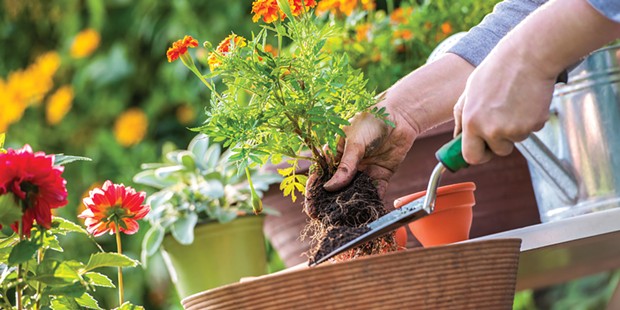[
{
"name": "Top Stories Video Pair",
"insertPoint": "7",
"component": "17087298",
"parentWrapperClass": "fdn-ads-inline-content-block",
"requiredCountToDisplay": "1"
}
]
Last month we talked about the importance of planning out a garden design on paper to create a beautiful space that is easier to maintain, more abundant and, at the end of the day, better connected to the surrounding environment.
We left off by working through the first half of a step-by-step system I developed called GOBRADIME — which stands for Goals, Observation, Boundaries, Resources, Analysis, Design, Implementation-Maintainance/Monitoring and Evaluate/Enjoy. Now it's time for the DIME part.
As you start to hone your plan, here are some helpful questions to ask yourself:
What work can I avoid doing?
How is everything affecting everything else?
What are the yields and how can they be improved?
How can I make the least change for the greatest effect?
Where are the imbalances and how can they be corrected?
What are the best and worst places for each element/plant/structure?
How can I use what is available now to turn problems into solutions?
What are the economic and ecological costs to implement and maintain the design?
If nothing was here, what would I bring in? What is here now that I need to remove?
Find connections, think about relationships, and start choosing where and when to make changes.
Don't overlook the value of intuition, aesthetics and random assembly as design tools. Sometimes just putting a plant where you think it looks nice, or where you happened to set it down first, works better than anything else. If you get stuck, try using a process of elimination by asking: "Where shouldn't this go?" and see where that takes you.
I'd love to get in deeper with the massive range of strategies for analyzing goals, observations, boundaries and resources, but for now I'll just say that you simply MUST go on the internet and look up "permaculture zones and sectors" for a major geek-out and irreplaceable tool.
Design: Make a bunch of photocopies of your base map and do a handful of completely different designs to warm up your imagination. Now go through everything again and write a list of actions that will bring your visions into reality. Prioritize these actions by sorting them according to goals, budgets, seasons, etc. Write down how many labor hours you estimate for each step. Think in terms of phases, and make realistic plans according to your boundaries: Which goal do they help to meet and how important that goal is to you? From here you should be able to develop a timeline that makes sense, attached to visual maps of what your garden will look like in a month, three months, six months, two years, and as far out as you want.
Implementation. This is the time to stop writing and start actually moving stuff around. Get busy! Continue to jot down notes as you develop new ideas or make changes to the original design — this will save time later when you evaluate your work. But also, pace yourself so you stay sane and are able to follow through with the rest of the plan. Don't burn yourself out. Take your time and focus on doing less right, rather than more wrong. And be sure to take plenty of time to step back, rest and reflect on your progress.
Maintenance and Monitoring. All gardens need maintenance. When clients tell me they want a "no-maintenance" garden design, I tell them to plant gravel. But it's true that some gardens need less care than others, and it's the space between that provides us with information and opportunity for improvement. That's why maintenance and monitoring are interconnected, inseparable steps. Ideally, in a home system you will be living in and interacting with the design as it comes about. Pay attention to the ways in which your life improves or becomes more difficult through these changes. Some people develop detailed forms to document the data generated by their projects, such as growth rates, yields and potential yields, and climatic patterns. Others might keep a simplier garden journal, or maybe just take photos and mental notes. However much detail you choose, the point of monitoring your progress is to find and record successes and problems (including potential problems) with the design, so you can either repeat effective patterns or go back and redesign failed ones.
Evaluate and Enjoy! Identify strengths, weaknesses, opportunities and challenges. Attach these notes to the maps and journals. As you evaluate, you will discover new goals, new ideas, and new ways to improve the efficiency and ecological integrity of your design. When you are ready, start again at the beginning, establish new goals and spiral around to the next phase of your project. But first, hit the hammock. Rest, read, relax and enjoy your bountiful, beautiful garden. You earned it!
Finally, remember that your project, if it involves people and especially if it involves plants, is an organism rather than a mechanism. The GOBRADIME design system, like any other, is most effective when coupled with a good degree of common sense and natural intuition. Trust your instincts and use the formula to help you refine them. But be careful not to become obsessed with controlling every aspect of the design. Mistakes are tools for learning! Take notes, laugh often and use GOBRADIME as a circular pattern, rather than a linear process. Have fun!
Heather Jo Flores is an avid seed saver and the author of Food Not Lawns, How to Turn Your Yard into a Garden and Your Neighborhood into a Community. Find her at www.heatherjoflores.com.
more from the author
-
Tales from the Underground
A rainbow of roots from around the world
- Sep 21, 2017
-
Hashtag, Bumper Crop
Veggies to plant now for fall and winter
- Aug 17, 2017
-
Think Outside the Garden Box
- Mar 9, 2017
- More »


































